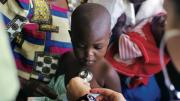Zasembo Mkhize, age eight, has come to the doctor dressed in a hot-pink-and-white outfit, immaculately coordinated down to her shoes and socks. She is HIV-positive and comes each month for a checkup at the pediatric HIV clinic of Don McKenzie Hospital, in South Africa’s KwaZulu-Natal province, where 39 percent of residents have HIV.
Her doctor, Brian Zanoni, an internist and pediatrician at Massachusetts General Hospital (MGH) and master’s candidate at Harvard School of Public Health (HSPH), is spending three years working in KwaZulu-Natal. In the exam room, he sits down with the girl and goes through a picture book—a teaching tool he created that explains HIV and the concept of immunodeficiency in simple terms and presents the information, piece by piece, in consecutive visits. Today, Zanoni reads a few pages explaining that the body has a natural defense against the “bad guy” in the story—the igciwane, or virus. He declares Zasembo’s CD4+ count, a measure of her immune function, “fantastic.” “She’s doing very, very well,” he tells her mother. “Her igciwane is asleep.” He continues with the story: if Zasembo keeps taking her medication, the virus will stay asleep. But if she stops, it gives the igciwane a defense against the amasotsha—the body’s soldiers (the CD4+ immune cells).
Zanoni often sees patients into the evening, but today all the children have been attended to by 3 p.m., so he agrees to see some of the waiting adults. In walks Makhosi Khwela, a pregnant 36-year-old with lively eyes who is also here for the HIV clinic.
Zanoni’s first question is how far along she is. Eight months. He asks through his translator whether she is on antiretrovirals yet. No. “You’ll start on them today.” He pages through her chart. Test results from five months ago would have qualified her for antiretroviral therapy (ART), but her local clinic referred her to Don McKenzie, where she can get the drugs, only last week. If she had started the drugs before conception, her unborn son’s risk of getting HIV would have been less than 1 percent. Now, the baby’s chance of infection is between 20 and 45 percent; Khwela’s viral load won’t drop all the way down before her due date.
Zanoni says later that he won’t bother calling the rural clinic to complain; it isn’t worth it. He’ll just continue treating whoever shows up at Don McKenzie. In some parts of KwaZulu-Natal, two-thirds of pregnant women have HIV.
His experiences illustrate the challenges of combating HIV in sub-Saharan Africa. There are too few doctors, and what healthcare workers there are need better training. Government resources and political will are often scarce. Limited infrastructure inhibits healthcare delivery. The stigma surrounding the disease and distrust of the health system deter people from seeking care.
Not that wealthy countries are perfect when it comes to HIV: misconceptions, reckless behavior, and obstacles to healthcare access exist there, too. But in the developed world, HIV is largely a chronic illness: patients have access to the drugs that enable them to lead long, productive, and healthy lives. In most of sub-Saharan Africa, this is not the case.
There is still no cure for HIV, and robust research efforts seek new knowledge: a vaccine, better medications, and greater understanding of the immune response to the disease. Meanwhile, initiatives such as Zanoni’s in South Africa aim to maximize the effect of existing knowledge by getting people tested and treated, and changing behavior. Such efforts, with their focus on social and behavioral factors, complement scientific research in the effort to control HIV, case by case, across Africa.
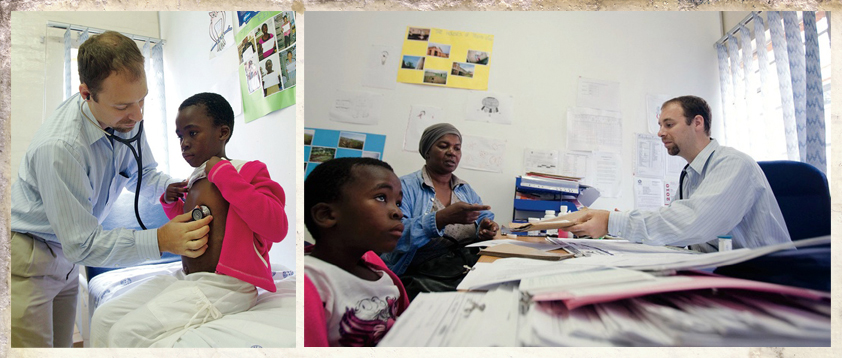
Photographs by Nadine Hutton
In the HIV clinic at Don McKenzie Hospital in South Africa’s KwaZulu-Natal province, eight-year-old Zasembo Mkhize visits pediatrician Brian Zanoni for her monthly checkup.
Zanoni’s job in KwaZulu-Natal includes a bit of everything: seeing patients, training health workers, opening rural clinics to bring care closer to patients, running a support group for HIV-positive teens, and conducting research on tuberculosis (still rampant in the area, mainly among HIV patients, with their weakened immune systems).
His work is part of the Umndeni Care Program, an initiative of the Ragon Institute. (Funded by MGH, MIT, and Harvard, the institute’s main mission is HIV vaccine research.) HIV patients are supposed to visit a clinic each month for medication, or for monitoring if they don’t yet need medication, but many simply stop com ing. The overtaxed doctors and clinic staff can’t follow up on them, so Umndeni Care—umndeni means “family” in Zulu—also employs “community liaison officers” like Dudu Ndlovu to help out.
Ndlovu grew up in KwaZulu-Natal’s Valley of a Thousand Hills, where she now conducts home visits (and where Don Mc-Kenzie is located). She visits patients each weekday, driving her pickup truck through this rolling terrain. For her clients, she represents a familiar face, and they place more trust in her than they would an American visitor. She is part healthcare worker, part social worker, answering questions about medication and symptoms, helping people with paperwork for government grants for themselves or dependent children, offering general moral support, and reporting back to Zanoni on clients who might need additional follow-up.
This well-rounded approach is a hallmark of Umndeni Care, says Bushra Taha ’06, a third-year student at Harvard Medical School who was in KwaZulu-Natal from 2006 to 2008 helping establish the program. (Its funding comes from investment banker Mark Schwartz ’76, M.B.A. ’78, M.P.P. ’79, and his wife, Lisa; Poorvu family professor of management practice Arthur Segel and his wife, U.S. District Court judge Patti Saris ’73, J.D. ’76; Lauren and Gary Cohen; the Sullivan Family Foundation; the Gilead Foundation; and the MGH multicultural affairs office.) Taha and her colleagues first spent several months conducting community surveys, listening to people’s concerns, and concluded that to improve treatment adherence, they needed to help address matters such as food, housing, and employment. It’s not uncommon for surviving adults to be caring for nieces, nephews, grandchildren, and children of friends who have died of AIDS—sometimes a dozen children or more. “How do you expect people to address their healthcare needs,” asks Taha, “when they can’t put food on the table?”
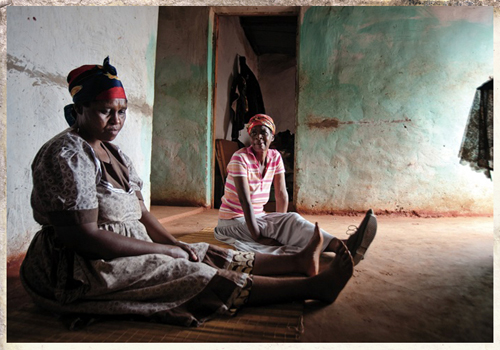
Photograph by Nadine Hutton
In South Africa’s Valley of a Thousand Hills, Sibongile Xaba (left) cares for her sister, Beatrice, who has HIV. Through a program supported by Massachusetts General Hospital, the sisters receive support for Beatrice’s care in the form of home visits.
Ndlovu’s client list today includes Beatrice and Sibongile Xaba, sisters living in an aqua-green house with a magnificent view—mountains, hills, valley, plateau. In their kitchen, two things hang on the wall: an icon of the Virgin and Christ, and a framed certificate that speaks to HIV’s painful impact on local culture. It reads:
Donda Funeral Services
Certificate of Appreciation
awarded to
Sibongile Xaba
for Outstanding Loyalty
to the company
and being a good payer.
When visitors arrive, Sibongile brings them a bench to sit on; coming out from the bedroom, Beatrice shuffles along the wall, supporting herself with one hand. This is an improvement: when Ndlovu started visiting a year ago, Beatrice was bedridden, smoking and drinking and taking only traditional medicines. Sibongile convinced her to get tested for HIV; that test came back positive, as did one for TB. Her CD4+ count was 179. (A count from 500 to 1,500 is considered normal; patients are generally started on ART if their count drops below 200 in the developing world, or 350 elsewhere.)
Although Beatrice has begun ART and TB treatment, and her health has improved, she dislikes the hospital and has been skipping appointments. Ndlovu advises her to go see “Dr. Brian.” Beatrice says she’ll go, and Ndlovu believes she will, remarking, “I don’t think she’ll be afraid to see the doctor whom I know.”
Kulwa Amiri Mbunju lives in Mburahati, a not-particularly-well-off section of Dar es Salaam, Tanzania. She has eight children, ranging in age from six to 23. In November 2008, feeling ill, she visited a doctor and learned that she was HIV-positive. She told her husband, and he got tested. When he found out that he, too, was infected, he committed suicide by taking all his malaria medication at once. He was 47. Asked how she earns a living now, Mbunju says through a translator that she makes money “whatever way I can.”
Two of her children (all of whom tested negative for HIV) are living with her niece. But the niece’s mother (Mbunju’s sister) isn’t allowed to know that the children are under her daughter’s care. She blames her sister for contracting HIV, and wouldn’t approve of helping her.
Mbunju told the neighbors in her shared house that she was HIV-positive when she moved in; if she had an accident and needed their help, she wanted them to know. They didn’t appreciate the gesture. Mbunju says she wants to move elsewhere once she gets a little money: “Everything I touch, they put it in the trash can.”
She relates this during a visit with Amina Kiloko, a community health worker employed by Pathfinder International, a U.S.-based nongovernmental organization (NGO). In Tanzania, as in South Africa, HIV patients are supposed to see a physician once a month, but it can take years for a patient to get ill enough to qualify for ART. “It’s consuming most of the doctor’s time to see people who are just coming for a regular checkup,” says Marc Mitchell, an HSPH lecturer on public health whose research in Dar es Salaam seeks to address such inefficiencies in the healthcare system. He can understand why a patient would choose not to come back: take a day off work and spend it in a hospital waiting room, just to be told you’re healthy enough and sent home for another month. But once patients fall out of the habit, they often don’t see a doctor again until they are gravely ill.
Through Pathfinder International and other NGOs, workers like Kiloko were already visiting patients in their homes, providing medical and general support in a model similar to Umndeni Care in South Africa. Mitchell has designed an intervention that eases both the strain on doctors and the frustrations of patients: mobile devices that enable community health workers to perform many of the same tasks a doctor would carry out in an office visit. The device serves up questions, which Kiloko asks Mbunju; through the answers Kiloko enters, the device is programmed to choose follow-up questions and make recommendations. It might tell Kiloko to conclude the visit and make an appointment for next month, to refer the patient to a doctor, or to recommend a specific diagnostic test. Mitchell’s trial found a very low percentage of error in the workers’ recommendations, and the Tanzanian government is considering recognizing a visit from a community health worker in lieu of the monthly doctor visit currently required.
Workers like Kiloko, who have minimal medical training, deliver better care with the aid of these devices—but so do healthcare professionals in clinics, Mitchell’s research has found: they more reliably make the right recommendation, and are less likely to forget an important question. Mitchell draws parallels to the “checklist” concept that is catching on in the United States (see “A Checklist for Life,” September-October 2009, page 32): because medicine is complex and healthcare workers are stressed, a standardized set of questions reduces the rate of error.
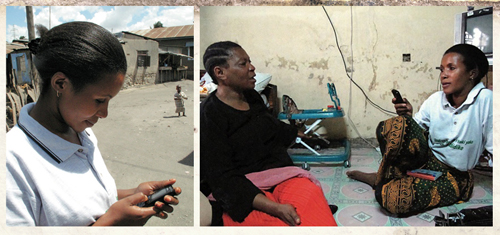
Photographs by Elizabeth Gudrais
In Dar es Salaam, Tanzania, community health worker Amina Kiloko visits HIV-positive clients, including Kulwa Amiri Mbunju, at home to provide support for their treatment. In a project designed by Harvard School of Public Health lecturer Marc Mitchell, Kiloko uses a mobile device equipped with software that helps her assess her clients’ health; she enters her findings into the device to create an electronic medical record.
The device is simple and inconspicuous: a regular mobile phone, with special software loaded onto it. Training someone to use it takes less than one hour. Placed in the hands of workers like Kiloko, Mitchell believes it could revolutionize the delivery of healthcare in resource-poor settings, making care available to vastly greater numbers of people for a low price. When workers complete an appointment or their daily shift, they upload the data they’ve gathered over the mobile-phone network. When used at clinics, the devices automatically create electronic health records, and if implemented widely enough, a network of them could provide disease surveillance, allowing for immediate and precise tracking of epidemics—tasks that are challenging even in the best of conditions.
Mitchell believes the Tanzanian government’s willingness to try something new—to let D-Tree (the NGO he founded to carry on the treatment work that falls outside the limits of research studies, which are funded by U.S. government grants through Harvard) into government clinics to test the devices without bureaucratic hassles—may enable its healthcare system to leapfrog ahead of some developed countries. “In the United States, everybody wants the perfect system,” he says. “In Tanzania, people are willing to accept a system that works.”
The device itself is the most salient feature of the program, but Mitchell views his work as being more about healthcare quality than about technology. “The goal,” he says, “is that this will become the way all healthcare is delivered”—not just HIV care. About 40 healthcare workers have phones running D-Tree software right now; within a year, Mitchell expects that number to reach 300 or 400, and to begin to grow “exponentially” and to extend into other countries.
Although D-Tree’s software initially focused on specific conditions—HIV, malaria—broadening the focus is a top priority; workers have already begun delivering family-planning services, prenatal and neonatal care, and child healthcare on their visits. A well-rounded approach makes more sense than a narrow one, because a child who’s HIV-positive might also have malaria, says Mitchell: “You can’t have separate systems for each disease.”
The D-Tree workers are involved in research that aims to change the way healthcare is delivered, but their work is also deeply human. Through Kiloko, Mbunju has been connected to a community of other HIV patients in the neighborhood. In fact, she meets Kiloko at the home of one of these other patients, because she doesn’t want her housemates to gossip more. The genuine friendship between the women is apparent—a small bright spot in this hard life.
Mbunju isn’t sick right now. Given the antiretroviral medications she is taking, the viral load in her blood is low and the number of CD4+ immune cells high—key indicators that her immune system is still healthy enough to fend off the opportunistic infections that would signal HIV’s development into AIDS. And she has made herself an unofficial “community ambassador.” Everywhere she goes, she brandishes her light-blue health card—where her appointments with Kiloko, her CD4+ count, and her prescriptions are recorded—and tells people she’s HIV-positive and not embarrassed about it. “What I’ve been through,” she says, “I wouldn’t want anybody to go through.”
A smooth, freshly paved highway connects Arusha and Moshi, the cities that serve as twin pit stops for Kilimanjaro-bound tourists. Buses and all-terrain vehicles shuttle back and forth all day long on hiking excursions, safaris, and airport runs. But not far from this highway exists a Tanzania that most tourists never see.
The transition is sudden: the roads turn to dirt and people are walking, not driving, transporting water jugs on their heads or on a donkey ambling alongside. There is little formal employment here, and few households have electricity. The lifestyle of ordinary Tanzanians is still heavily influenced by tribal culture; local languages endure alongside widespread knowledge of Swahili.
In these villages, a group of international university students—including several from Harvard—serves as volunteer educators for the NGO Support for International Change (SIC). In churches, schools, and village centers in close to 100 communities in this region, the volunteers teach about HIV.
Tanzania’s infection rate, 6 percent, is not close to the highest in Africa, but the country still ranks among the top 10 worldwide in terms of HIV deaths each year. The vast majority of Tanzanians living with HIV do not know they are infected. Often, people are not diagnosed until they are too sick to save. Persistent misconceptions and rumors—about how the virus spreads, how it is treated, and the testing process—stand in the way of getting people tested and treated, and stopping new infections.
The villagers sometimes receive foreigners with friendliness, sometimes with wariness. One sunny Sunday, a group of volunteers encounters both in the lush, green village of Nsengony. In the morning, teaching in a Lutheran church at the end of services, Hannah Chung ’09 and Nita Bhatia ’09 are relieved when, at the end of their talk introducing the basics of HIV and urging people to visit a nearby site for free testing later in the day, the congregation responds with applause. Earlier, the pastor had given both of them explicit instructions about reproductive health information they could not mention in their talk, and they were worried about how receptive he would be. As the service ends and people leave, they hear the pastor himself say the word kupima (“testing” in Swahili) in conversation—a good sign.
That afternoon, Bhatia and Anton Massanja, a Tanzanian university student who is her “teaching partner” for the summer, walk around Nsengony with SIC program officer Jamie Clearfield. On days when free testing is offered, the volunteers knock on doors and talk to people walking down the street, encouraging everyone to come and be tested.
Outside one brick house, adults sit in the shade while children mill around playing; Kilimanjaro rises in the background. The family listens patiently as the volunteers in their crimson SIC polo shirts tell them there’s free testing going on and ask if they’ve ever been tested. (Bhatia and Clearfield speak in halting Swahili, with translation help from Massanja.) But the woman of the house cuts them off, saying that this is a pious family, that their prayers will protect them and cure them if they do become infected.
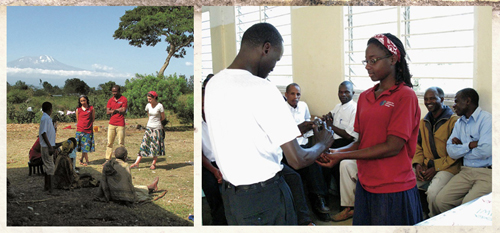
Photographs by Elizabeth Gudrais
In northern Tanzania, American and Tanzanian volunteers with Support for International Change conduct HIV education and testing drives. Above left: Nita Bhatia ’09, Anton Massanja, and Jamie Clearfield encourage villagers in Nsengony to take advantage of free testing nearby. Above right: During an educational session at a technical high school in Leguruki village, Katherine Sengoba ’10 helps a student practice the correct method of putting on a condom.
SIC’s leaders are keenly aware of how presumptuous it might seem for foreigners to show up on someone’s doorstep and suggest that the person be tested for a sexually transmitted infection. They take great care to be as sensitive and non-intrusive as possible. Before arriving in Tanzania, the American volunteers receive eight weeks of training, with a focus on local culture and dealing with touchy situations, as well as HIV biology. Once they arrive, they work side by side with Tanzanian “teaching partners”: young adults who are not just translators, but fellow educators with equal status. The volunteers and teaching partners make a big push for testing and education each summer; in between, and in the villages where volunteers may not visit even once a year, SIC hires and trains community health workers (also native Tanzanians) who maintain a consistent SIC presence by conducting year-round education, testing, and support for people living with HIV.
Gratifying as it might have been if the family living in the mountain’s shadow had simply come along for testing that afternoon, Bhatia was content to have made an impression through the conversation, and perhaps planted a seed. “When you’re going into a place where there is a lot of stigma around these issues, and on top of that you can’t speak the language properly, and you’re just foreign in every way,” she says, “it’s a lot to expect people to be willing to listen to you and trust you.”
The next day, another group of SIC educators heads to Leguruki village to teach high-school students at Shule ya Ufundi Leguruki—the Leguruki Technical School. Their program consists of matter-of-fact delivery of information, intermixed with games. There is no room for being bashful: in teaching about the modes of HIV transmission, Katherine Sengoba ’10 notes that sex is by far the most common mode, accounting for 80 percent of new infections in Tanzania. She makes the students repeat the Swahili word for sex (Ngono!!!!) over and over, louder and louder, until she is satisfied that it was loud enough and all the students are dissolving in laughter.
The program takes direct aim at some of the myths that underpin risky behavior. For instance, rumors circulate that condoms actually carry HIV and are part of a U.S. government conspiracy to kill black Africans; the SIC materials specify that the brand of condoms they distribute, Salama, is made “in Tanzania, by Tanzanians, for Tanzanians.” To debunk another rumor, that condoms have holes that allow for HIV transmission, the volunteers fill condoms with water and walk around the room twirling them like balloons, demonstrating that not a drop of water is spilled.
The session’s grand finale is a game—and now things move from frank to really frank. Sengoba takes out a model of a penis and parades it around the room, allowing herself to smile but not to laugh as the students go berserk. Then Byran Dai ’11 asks for two students who are fast runners. Two young men volunteer; when Dai says they’ll compete to see who can be first to run across the room, correctly put a condom on the model and remove it, and run back, one of them looks as though he knew it was coming; the other looks positively mortified. During the race, when the second student removes the condom in entirely the wrong manner, Dai winces, but quickly recovers his composure and makes the example into a teaching moment. Using a condom in real life is “very rushed,” and could be even more difficult than demonstrating it in front of all your friends, he tells the class. “There’s a lot of pressure. Usually someone is watching you.”
Speaking this openly about sex, especially to teenagers, isn’t easy. But SIC’s training course includes lots of practice, and there is a good incentive, the Harvard students say. “I knew that I had to keep a straight face and be mature about it if they were going to take me seriously,” says Bhatia, who now works as a research coordinator in the clinical trials office at Mount Sinai Medical Center in New York City.
The work in Tanzania helped her see that she does want to practice medicine one day—and that seeing patients “is not just about prescribing medication. It’s about educating people.” Education, she says, is one of a doctor’s most important functions: helping patients understand diseases, treatment options, and how to protect their own health. In the fight against HIV, these interactions are at least as crucial as budgets for prescription drugs and vaccine research—small victories, person to person, day by day.
